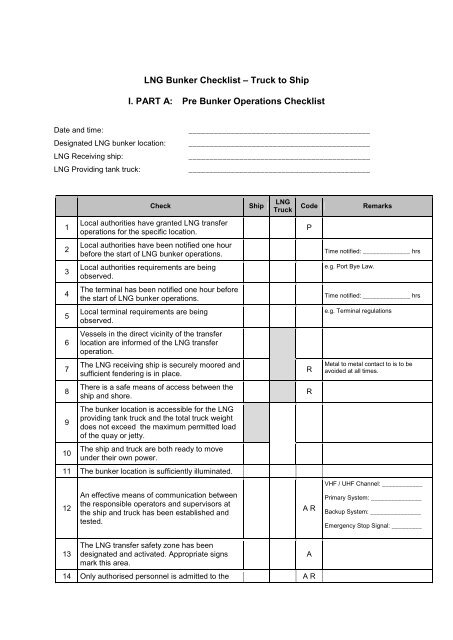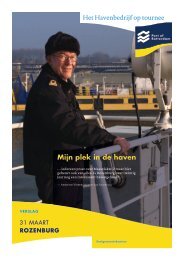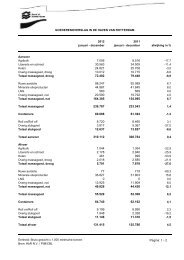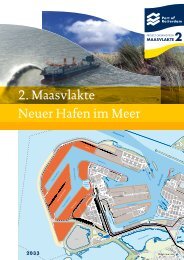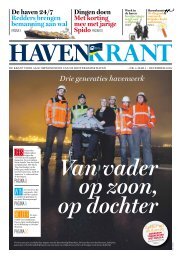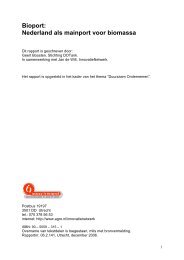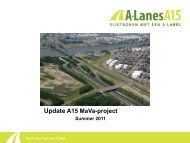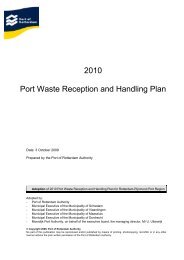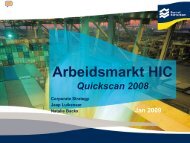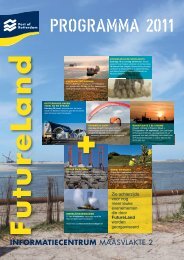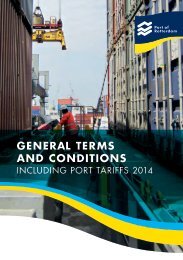LNG Bunker Checklist â Truck to Ship I. PART A ... - Port of Rotterdam
LNG Bunker Checklist â Truck to Ship I. PART A ... - Port of Rotterdam
LNG Bunker Checklist â Truck to Ship I. PART A ... - Port of Rotterdam
You also want an ePaper? Increase the reach of your titles
YUMPU automatically turns print PDFs into web optimized ePapers that Google loves.
<strong>LNG</strong> <strong>Bunker</strong> <strong>Checklist</strong> – <strong>Truck</strong> <strong>to</strong> <strong>Ship</strong><br />
I. <strong>PART</strong> A: Pre <strong>Bunker</strong> Operations <strong>Checklist</strong><br />
Date and time:<br />
Designated <strong>LNG</strong> bunker location:<br />
<strong>LNG</strong> Receiving ship:<br />
<strong>LNG</strong> Providing tank truck:<br />
___________________________________________<br />
___________________________________________<br />
___________________________________________<br />
___________________________________________<br />
Check<br />
<strong>Ship</strong><br />
<strong>LNG</strong><br />
<strong>Truck</strong><br />
Code<br />
Remarks<br />
1<br />
Local authorities have granted <strong>LNG</strong> transfer<br />
operations for the specific location.<br />
P<br />
2<br />
Local authorities have been notified one hour<br />
before the start <strong>of</strong> <strong>LNG</strong> bunker operations.<br />
Time notified: ______________ hrs<br />
3<br />
Local authorities requirements are being<br />
observed.<br />
e.g. <strong>Port</strong> Bye Law.<br />
4<br />
The terminal has been notified one hour before<br />
the start <strong>of</strong> <strong>LNG</strong> bunker operations.<br />
Time notified: ______________ hrs<br />
5<br />
Local terminal requirements are being<br />
observed.<br />
e.g. Terminal regulations<br />
6<br />
Vessels in the direct vicinity <strong>of</strong> the transfer<br />
location are informed <strong>of</strong> the <strong>LNG</strong> transfer<br />
operation.<br />
7<br />
The <strong>LNG</strong> receiving ship is securely moored and<br />
sufficient fendering is in place.<br />
R<br />
Metal <strong>to</strong> metal contact <strong>to</strong> is <strong>to</strong> be<br />
avoided at all times.<br />
8<br />
There is a safe means <strong>of</strong> access between the<br />
ship and shore.<br />
R<br />
9<br />
The bunker location is accessible for the <strong>LNG</strong><br />
providing tank truck and the <strong>to</strong>tal truck weight<br />
does not exceed the maximum permitted load<br />
<strong>of</strong> the quay or jetty.<br />
10<br />
The ship and truck are both ready <strong>to</strong> move<br />
under their own power.<br />
11 The bunker location is sufficiently illuminated.<br />
VHF / UHF Channel: ____________<br />
12<br />
An effective means <strong>of</strong> communication between<br />
the responsible opera<strong>to</strong>rs and supervisors at<br />
the ship and truck has been established and<br />
tested.<br />
A R<br />
Primary System: _______________<br />
Backup System: _______________<br />
Emergency S<strong>to</strong>p Signal: _________<br />
13<br />
The <strong>LNG</strong> transfer safety zone has been<br />
designated and activated. Appropriate signs<br />
mark this area.<br />
14 Only authorised personnel is admitted <strong>to</strong> the A R<br />
A
<strong>LNG</strong> transfer safety zone.<br />
15<br />
The <strong>LNG</strong> transfer safety zone is free <strong>of</strong> ignition<br />
sources.<br />
R<br />
Including vehicles other than the <strong>LNG</strong><br />
tank truck.<br />
16<br />
Regulations with regards <strong>to</strong> ignition sources are<br />
observed both on the ship and on the shore.<br />
These include but are not limited <strong>to</strong> smoking<br />
restrictions and regulations with regards <strong>to</strong><br />
naked light, mobile phones, pagers, VHF and<br />
UHF equipment, radar and AIS equipment.<br />
A R<br />
Radars are switched <strong>of</strong>f.<br />
Fixed radio (VHF / UHF / AIS)<br />
transceivers are on the correct power<br />
mode or are switched <strong>of</strong>f.<br />
17<br />
Fire-fighting equipment on board the receiving<br />
ship is ready for immediate use.<br />
18<br />
The tank truck fire-fighting equipment is ready<br />
for immediate use.<br />
19<br />
The procedures for bunker operations and<br />
purging have been agreed upon by both ship<br />
and truck.<br />
A<br />
I. <strong>PART</strong> B: Pre <strong>LNG</strong> Transfer <strong>Checklist</strong><br />
Check<br />
<strong>Ship</strong><br />
<strong>LNG</strong><br />
<strong>Truck</strong><br />
Code<br />
Remarks<br />
20<br />
Adequate supervision <strong>of</strong> the operation is in<br />
place both on the ship and at the tank truck and<br />
an effective watch is being kept at all time.<br />
21<br />
Present weather and wave conditions are<br />
within the agreed limits.<br />
A R<br />
Wind:<br />
______________________<br />
Waves: _______________________<br />
22<br />
No other vessels are within the predetermined<br />
safety distance from the <strong>LNG</strong> transfer safety<br />
zone.<br />
R P<br />
Local requirements: _______ mtr / ft<br />
[ Recommended minimum distance by<br />
WPCI: 25 mtr / 82 ft ]<br />
23<br />
All external doors, portholes and<br />
accommodation ventilation inlets are closed.<br />
R<br />
24<br />
The gas detection equipment has been<br />
properly calibrated for natural gas. It has been<br />
tested and found <strong>to</strong> be in good working order.<br />
25<br />
Material Safety Data Sheets (MSDS) for the<br />
<strong>LNG</strong> product have been exchanged.<br />
A<br />
26<br />
Emergency signal and the shutdown<br />
procedures have been agreed upon, tested,<br />
and explained <strong>to</strong> personnel involved.<br />
A<br />
27<br />
Sufficient suitable protective clothing and<br />
equipment is ready for immediate use.<br />
28<br />
Personnel involved in the connection and<br />
disconnection <strong>of</strong> the bunker hoses and
personnel in the direct vicinity <strong>of</strong> these<br />
operations are supplied with appropriate<br />
protective clothing.<br />
29<br />
Hand <strong>to</strong>rches (flashlights) are <strong>of</strong> an approved<br />
explosion pro<strong>of</strong> type.<br />
30<br />
Scuppers at the <strong>LNG</strong> transfer area are kept<br />
open.<br />
31<br />
<strong>Bunker</strong> pumps and compressors are in good<br />
working order.<br />
A<br />
Where applicable.<br />
32<br />
All remote control valves are well maintained<br />
and in good working order.<br />
33<br />
<strong>Bunker</strong> system gauges, high level alarms and<br />
high pressure alarms are operational, correctly<br />
set and in good working order.<br />
34<br />
All safety and control devices on the <strong>LNG</strong><br />
installations are checked, tested and found <strong>to</strong><br />
be in good working order.<br />
35<br />
Boil <strong>of</strong>f and pressure control equipment is<br />
operational and in good working order.<br />
36<br />
Emergency shutdown devices (ESD’s) have<br />
been tested and are found <strong>to</strong> be in good<br />
working order.<br />
37<br />
Closing rates for the ESD valves and / or<br />
similar au<strong>to</strong>matic devices have been<br />
exchanged between ship and truck.<br />
A<br />
38<br />
Initial <strong>LNG</strong> bunker line up has been checked.<br />
Unused connections are closed, blanked and<br />
fully bolted.<br />
39<br />
<strong>LNG</strong> bunker hoses, fixed pipelines and<br />
manifolds are in good condition, properly<br />
rigged, supported, fully bolted, and certified for<br />
the <strong>LNG</strong> transfer.<br />
40<br />
Dry brake away couplings in the <strong>LNG</strong> bunker<br />
connections are in place and in a good working<br />
order.<br />
41<br />
Spill containment arrangements are <strong>of</strong> an<br />
appropriate volume, in position, and empty.<br />
e.g. Drip trays.<br />
42<br />
Adequate electrical insulating means are in<br />
place in the truck <strong>to</strong> ship connections.<br />
Where applicable.<br />
43<br />
Adequate electrical grounding connection is<br />
made between the tank truck and ship<br />
44<br />
The tank truck is electrically grounded and the<br />
wheels are chocked.<br />
45<br />
The tank truck engine is <strong>of</strong>f during the<br />
connection, purging and disconnection <strong>of</strong> the<br />
<strong>LNG</strong> bunker hoses.<br />
46<br />
The tank truck engine is switched <strong>of</strong>f during<br />
transfer.<br />
Unless the truck engine is required for<br />
transfer <strong>of</strong> <strong>LNG</strong>.
47<br />
Maximum working pressures have been agreed<br />
upon by ship and truck.<br />
A<br />
Max pressure: ____________bar abs.<br />
48<br />
Maximum and minimum pressures in the <strong>LNG</strong><br />
bunker tanks have been agreed upon by ship<br />
and truck.<br />
A Max pressure : ________ bar / psi<br />
Min pressure:<br />
________ bar / psi<br />
49<br />
Maximum and minimum temperatures <strong>of</strong> the<br />
<strong>LNG</strong> in the bunker tanks have been agreed<br />
upon by ship and truck.<br />
A<br />
Max temperature: ________ C / F<br />
Min temperature:<br />
________ C / F<br />
50<br />
Maximum filling limit <strong>of</strong> the <strong>LNG</strong> bunker tanks<br />
have been agreed upon by ship and truck.<br />
A Max filling limit: ________ %<br />
51<br />
Volume <strong>to</strong> be bunkered has been agreed upon<br />
by ship and truck.<br />
A <strong>Bunker</strong> volume # 1: _______ m 3 / ft 3<br />
<strong>Bunker</strong> volume # 2: _______ m 3 / ft 3<br />
Declaration<br />
We, the undersigned, have checked the above items in Parts A and B in accordance with the<br />
instructions and have satisfied ourselves that the entries we have made are correct.<br />
We have also made arrangements <strong>to</strong> carry out repetitive checks as necessary and agreed that those<br />
items coded ‘R’ in the <strong>Checklist</strong> should be re-checked at intervals not exceeding ______ hours.<br />
If, <strong>to</strong> our knowledge, the status <strong>of</strong> any item changes, we will immediately inform the other party.<br />
<strong>Ship</strong><br />
<strong>Truck</strong><br />
Name<br />
Name<br />
Rank<br />
Position<br />
Signature<br />
Signature<br />
Date<br />
Date<br />
Time<br />
Time<br />
Record <strong>of</strong> repetitive checks<br />
Date<br />
Time<br />
Initials for ship<br />
Initials for truck
Guidelines for completing the <strong>LNG</strong> <strong>Bunker</strong> <strong>Checklist</strong> <strong>Truck</strong> <strong>to</strong> <strong>Ship</strong><br />
The presence <strong>of</strong> the letters ‘A’ or ‘R’ in the column entitled ‘Code’ indicates the following:<br />
• A (‘Agreement’).<br />
This indicates an agreement or procedure that should be identified in the ‘Remarks’ column <strong>of</strong> the Check-List or<br />
communicated in some other mutually acceptable form.<br />
• R (‘Re-check’).<br />
This indicates items <strong>to</strong> be re-checked at appropriate intervals, as agreed between both parties, at periods stated in the<br />
declaration.<br />
• P (‘Permission’)<br />
This indicates that permission is <strong>to</strong> be granted by authorities.<br />
The joint declaration should not be signed until both parties have checked and accepted their assigned responsibilities and<br />
accountabilities.
II<br />
After <strong>LNG</strong> Transfer <strong>Checklist</strong><br />
Check<br />
<strong>Ship</strong><br />
<strong>LNG</strong><br />
<strong>Truck</strong><br />
Code<br />
Remarks<br />
52<br />
<strong>LNG</strong> bunker hoses, fixed pipelines and<br />
manifolds have been purged and are ready for<br />
disconnection.<br />
A<br />
53<br />
Remote and manual controlled valves are<br />
closed en ready for disconnection.<br />
A<br />
54<br />
After disconnection the <strong>LNG</strong> transfer safety<br />
zone has been deactivated. Appropriate signs<br />
have been removed.<br />
A<br />
55<br />
Local authorities have been notified that <strong>LNG</strong><br />
bunker operations have been completed.<br />
Time notified: ______________ hrs<br />
56<br />
The terminal has been notified that <strong>LNG</strong> bunker<br />
operations have been completed.<br />
Time notified: ______________ hrs<br />
57<br />
Vessels in the direct vicinity have been<br />
informed that <strong>LNG</strong> bunker operations have<br />
been completed.<br />
58<br />
Near misses have been reported <strong>to</strong> local<br />
authorities.<br />
Report nr: ___________________<br />
59<br />
Incidents have been reported reported <strong>to</strong> local<br />
authorities.<br />
Report nr: ___________________<br />
Declaration<br />
We, the undersigned, have checked the above items in accordance with the instructions and have<br />
satisfied ourselves that the entries we have made are correct.<br />
<strong>Ship</strong><br />
<strong>Truck</strong><br />
Name<br />
Name<br />
Rank<br />
Position<br />
Signature<br />
Signature<br />
Date<br />
Date<br />
Time<br />
Time
Guidelines for completing the <strong>LNG</strong> <strong>Bunker</strong> <strong>Checklist</strong> <strong>Truck</strong> <strong>to</strong> <strong>Ship</strong><br />
The presence <strong>of</strong> the letters ‘A’ or ‘R’ in the column entitled ‘Code’ indicates the following:<br />
• A (‘Agreement’).<br />
This indicates an agreement or procedure that should be identified in the ‘Remarks’ column <strong>of</strong> the Check-List or<br />
communicated in some other mutually acceptable form.<br />
• R (‘Re-check’).<br />
This indicates items <strong>to</strong> be re-checked at appropriate intervals, as agreed between both parties, at periods stated in the<br />
declaration.<br />
• P (‘Permission’)<br />
This indicates that permission is <strong>to</strong> be granted by authorities.<br />
The joint declaration should not be signed until both parties have checked and accepted their assigned responsibilities and<br />
accountabilities.


